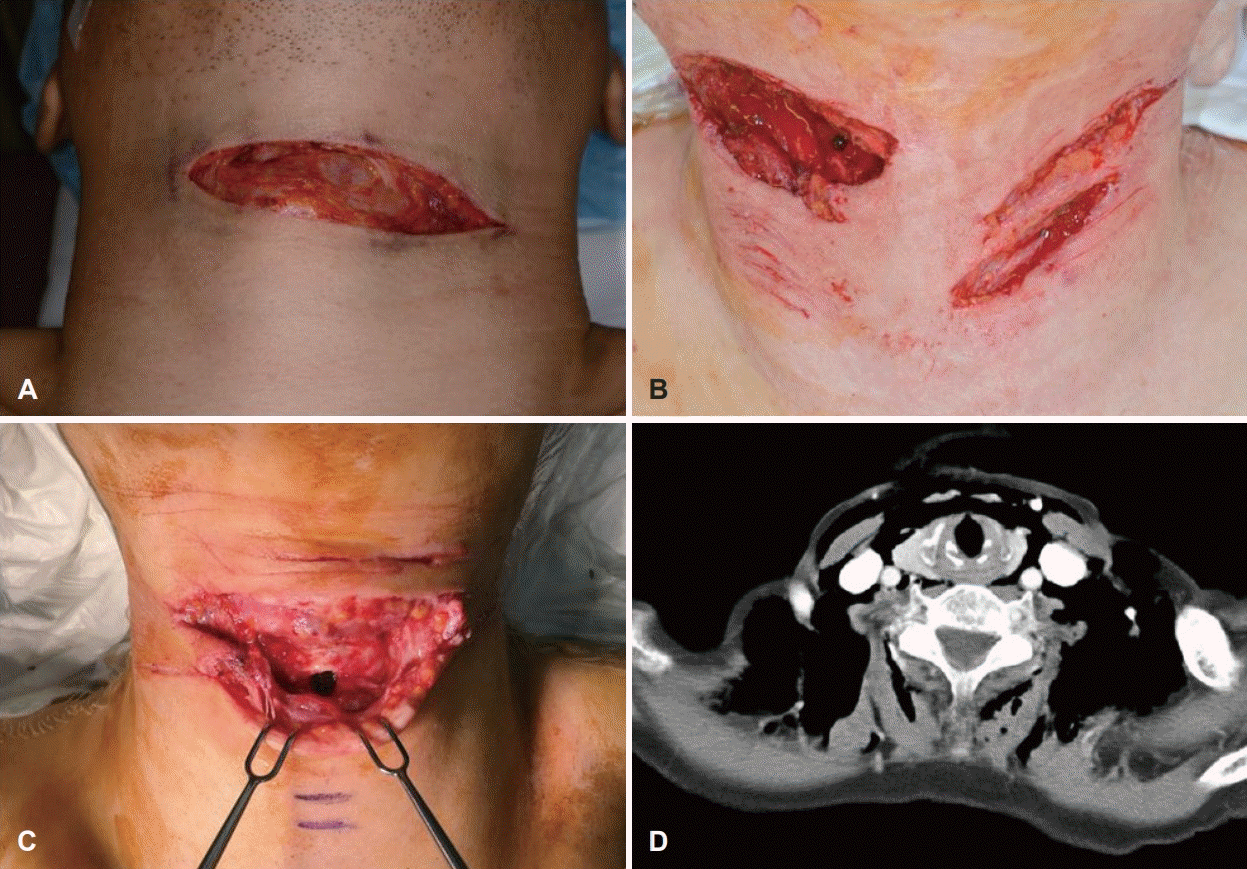1. Britt LD, Peyser MD. Penetrating and blunt neck trauma. In : Mattox KL, Feliciano DV, Moore EE, editors. Trauma. 4th ed. New York, NY: McGraw-Hill;2000. p. 437–50.
2. Grewal H, Rao PM, Mukerji S, Ivatury RR. Management of penetrating laryngotracheal injuries. Head Neck. 1995; 17(6):494–502.

3. Burgess CA, Dale OT, Almeyda R, Corbridge RJ. An evidence based review of the assessment and management of penetrating neck trauma. Clin Otolaryngol. 2012; 37(1):44–52.

4. Kim EH, Lee GH, Koo BS, Yoon YH. CSF leak and pneumocephalus caused by neck stab wound. Korean J Otorhinolaryngol-Head Neck Surg. 2009; 52(6):522–4.

5. Kim YH, Choi JS, Kang SH, Yu MS. Penetrating neck laceation with epiglottis amputation which was successfully repaired. Korean J Otorhinolaryngol-Head Neck Surg. 2012; 55(6):369–72.

6. Bhatt NR, McMonagle M. Penetrating neck injury from a screwdriver: Can the no zone approach be applied to zone i injuries? BMJ Case Rep. 2015; 2015:bcr2015212666.

7. Lee HK, Woo SH, Choi DS, Kim JP. A case of the zone III penetrating neck injury with internal carotid artery laceration treated by an urgent endovascular stent technique. Korean J Otorhinolaryngol-Head Neck Surg. 2010; 53(4):236–40.

8. Biétry D, Exadaktylos A, Müller T, Zbären P, Caversaccio M, Arnold A. Sharp neck injuries in suicidal intention. Eur Arch Otorhinolaryngol. 2015; 272(12):3825–31.

9. Ventrice D, Valach L, Reisch T, Michel K. Suicide attempters’ memory traces of exposure to suicidal behavior: A qualitative pilot study. Crisis. 2010; 31(2):93–9.
10. Herzog M, Hoppe F, Baier G, Dieler R. [Injuries of the head and neck in suicidal intention]. Laryngorhinootologie. 2005; 84(3):176–81.
11. Lim MR, Lee SJ, Park J-I. Characteristics of Korean suicide attempters. J Korean Neuropsychiatr Assoc. 2015; 54(2):209–15.

12. Lee WK, Kim Y. Drinking pattern and nonfatal injuries of adults in Korea. J Korean Soc Traumatol. 2009; 22(2):233–41.
13. Nason RW, Assuras GN, Gray PR, Lipschitz J, Burns CM. Penetrating neck injuries: Analysis of experience from a Canadian trauma centre. Can J Surg. 2001; 44(2):122–6.
14. Roon AJ, Christensen N. Evaluation and treatment of penetrating cervical injuries. J Trauma. 1979; 19(6):391–7.

15. Ibraheem K, Khan M, Rhee P, Azim A, O’Keeffe T, Tang A, et al. “No zone” approach in penetrating neck trauma reduces unnecessary computed tomography angiography and negative explorations. J Surg Res. 2018; 221:113–120.

16. Mahmoodie M, Sanei B, Moazeni-Bistgani M, Namgar M. Penetrating neck trauma: Review of 192 cases. Arch Trauma Res. 2012; 1(1):14–8.

17. Teixeira F, Menegozzo CA, Netto SD, Poggeti RS, Collet E Silva Fde S, Birolini D, et al. Safety in selective surgical exploration in penetrating neck trauma. World J Emerg Surg. 2016; 11:32.

18. McConnell DB, Trunkey DD. Management of penetrating trauma to the neck. Adv Surg. 1994; 27:97–127.





 PDF
PDF Citation
Citation Print
Print



 XML Download
XML Download